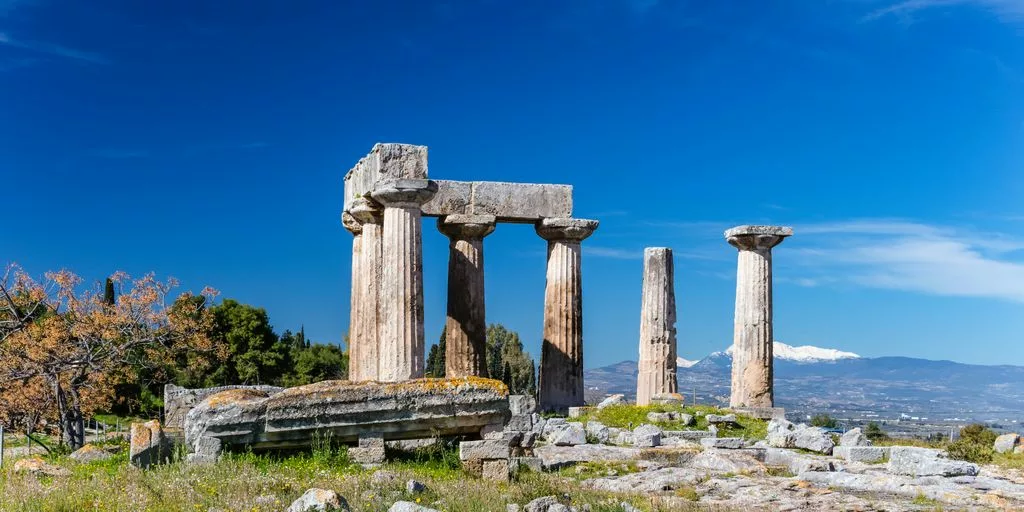
The Architectural Marvels of Ancient Egypt
Our journey begins in the land of pharaohs and pyramids – Egypt! Marvel at the Great Pyramid of Giza, the last standing wonder of the ancient world, and ponder over the age-old riddles surrounding its construction. Delve into the Valley of the Kings, where ancient rulers were laid to rest in elaborately adorned tombs, and witness the grandeur of the Sphinx guarding the Giza plateau. Unravel the secrets of hieroglyphics and immerse yourself in the captivating tales of Egyptian mythology.
Philosophical and Artistic Contributions of Ancient Greece

The Birth of Democracy
Ancient Greece is where democracy first took root. The government in Athens set the stage for many modern systems. This period was a time of political, philosophical, artistic, and scientific achievements that formed a legacy with unparalleled influence. The ideas of many Greek scholars have had a huge impact on Western mindset.
Classical Art and Sculpture
Greek art and sculpture are renowned for their beauty and precision. From the Parthenon Frieze to the statues of gods and heroes, the artistic contributions of ancient Greece continue to inspire. These works are not just art; they are a window into the soul of a civilization that valued beauty, balance, and harmony.
Philosophical Schools of Thought
In ancient Greece, philosophers like Socrates, Plato, and Aristotle debated about life, the universe, and everything else. Their philosophical inquiries laid the foundation for Western thought and the enduring impact of their teachings on philosophy, ethics, and governance. Exploring ancient ruins, historic neighborhoods, and lesser-known museums can give you a glimpse into their world.
Athens offers a blend of ancient and contemporary attractions. It’s a city where the past and present coexist, making it a must-visit destination for history enthusiasts.
The Roman Empire: Engineering and Innovation
Aqueducts and Roads
The Romans were great innovators and inventors, sometimes appropriating and advancing aspects from other cultures, and other times inventing entirely new techniques. Their aqueducts and roads are prime examples of their engineering prowess. These structures not only supplied water to cities but also connected the vast empire, facilitating trade and communication.
- Aqueducts: Carried water over long distances.
- Roads: Connected cities and military outposts.
Roman Architecture
From the grandeur of the Colosseum to the engineering marvel of aqueducts, the Roman Empire left an indelible mark on architecture. The use of arches, vaults, and concrete allowed for the construction of massive and durable structures. The Pantheon, with its impressive dome, is a testament to their architectural ingenuity.
The remnants of the Romans’ influence become visible as you wander the city.
Technological Advancements
Ancient Roman technology is the collection of techniques, skills, methods, processes, and engineering practices which supported Roman civilization and made it one of the most advanced of its time. Their mechanical innovation was not distinguished, and, even in the realms of military and construction engineering, in which they showed great ingenuity, they were ahead of their time. From the retractable roof of the Colosseum to the complex heating systems in Roman baths, their technological advancements were truly remarkable.
Mystical Traditions of Ancient India
The Vedic Period marks the dawn of ancient Indian culture. This era is known for its rich spiritual texts like the Vedas and Upanishads. These texts are the foundation of Hinduism and offer a glimpse into the early mystical thought of India. The Vedic hymns, rituals, and philosophies were not just religious practices but a way of life that influenced every aspect of society.
Buddhism and Jainism emerged as significant spiritual movements in ancient India. Both religions emphasized non-violence, self-discipline, and the quest for enlightenment. The teachings of Buddha and Mahavira provided an alternative to the ritualistic practices of the Vedic tradition. These contributions have left a lasting impact on Indian culture and continue to inspire people worldwide.
Ancient Indian art and literature are a testament to the country’s cultural diversity and creativity. From the intricate carvings of the Ajanta and Ellora caves to the epic tales of the Mahabharata and Ramayana, India’s artistic and literary heritage is vast and varied. These works not only reflect the spiritual richness of the time but also offer insights into the daily lives, beliefs, and values of ancient Indians.
India is a mystical country rich in cultural diversity, exotic customs, and ancient traditions that have stood the test of time. This country will surprise you with its depth and beauty, offering a journey of self-discovery and soul nourishment.
The Cultural Heritage of Ancient China
The Great Wall and Terracotta Army
The Great Wall of China and the Terracotta Army are two of the most iconic symbols of China’s rich history. The Great Wall, stretching over 13,000 miles, was built to protect Chinese civilization from invasions. Meanwhile, the Terracotta Army, discovered in the tomb of the first Emperor, Qin Shi Huang, showcases the incredible artistry and military might of ancient China.
Confucianism and Taoism
Confucianism and Taoism are two major philosophical traditions that have shaped Chinese culture for centuries. Confucianism, founded by Confucius, emphasizes moral integrity and social harmony. Taoism, on the other hand, focuses on living in harmony with the Tao, or the natural order of the universe. These philosophies have deeply influenced Chinese society, from family structures to governance.
Silk Road and Trade
The Silk Road was a network of trade routes that connected China to the rest of the world. This ancient trade route facilitated the exchange of goods, ideas, and cultures. China’s northern Fujian, as one of the spatial carriers of renowned traditional Chinese cultures such as Minyue, Zhu Xi’s Neo-Confucianism, tea, and porcelain, played a significant role in this exchange. The Silk Road not only boosted China’s economy but also enriched its cultural heritage.
China’s cultural heritage sites, recognized by UNESCO, are remarkable windows into the nation’s long and vibrant history, showcasing ancient monuments, temples, and more.
Mesoamerican Civilizations: The Aztecs and Mayans
The Aztecs and Mayans left behind impressive temples and pyramids that still captivate us today. These structures were not just architectural feats but also held deep cultural and religious significance. The Pyramid of the Sun and the Pyramid of the Moon are prime examples of this grandeur.
The Mayans were masters of astronomy and mathematics. They developed intricate calendar systems that were incredibly accurate. Their understanding of celestial movements was so advanced that it still amazes modern scientists.
The cultural practices and beliefs of the Aztecs and Mayans were rich and varied. From the floating gardens of the Aztecs to the complex rituals of the Mayans, these civilizations had a profound impact on the world. Their traditions in art, music, and daily life continue to influence us today.
Hidden within the dense jungles of Central America, the Mayan civilization thrived with remarkable advancements in various fields. Their legacy is a testament to human ingenuity and creativity.
The Legacy of Ancient Mesopotamia
The Cradle of Civilization
Venture into the cradle of civilization and discover the marvels of Mesopotamia. This ancient land, located in modern-day Iraq, is where human civilization began. From the bustling city of Babylon to the awe-inspiring Ishtar Gate, Mesopotamia’s legacy endures through its profound impact on human civilization. The innovations of ancient Mesopotamia laid the foundations for literacy, law, administration, and scientific inquiry, shaping the very essence of contemporary society.
Cuneiform Writing
Delve into the origins of writing with the ancient Sumerians, who developed cuneiform script. This early form of writing was etched onto clay tablets and used for everything from recording transactions to composing literature. The invention of writing in Mesopotamia was a monumental leap for humanity, enabling the documentation of history, culture, and knowledge.
Ziggurats and Temples
Explore the architectural wonders of Mesopotamia, such as the ziggurat of Ur. These ancient stepped pyramids were not only religious centers but also symbols of the ingenuity of Mesopotamian architects. Each ziggurat was dedicated to a specific deity and served as a focal point for the community’s spiritual and social life.
Mesopotamia’s contributions to civilization are vast and varied, from the creation of writing systems to the construction of monumental architecture. This ancient culture’s influence can still be felt in many aspects of modern life.
Conclusion
As we wrap up our journey through ancient cultures, it’s clear that these civilizations have left a lasting impact on our world. From the towering pyramids of Egypt to the philosophical ideas of ancient Greece, each culture has contributed something unique. By learning about their stories, we not only appreciate their achievements but also understand how they have shaped our present. So, let’s continue to explore, learn, and respect these incredible legacies as we move forward in our own lives.
Frequently Asked Questions
What are the Pyramids of Giza?
The Pyramids of Giza are ancient pyramid structures in Egypt. They were built as tombs for pharaohs and are among the most famous monuments in the world.
How did ancient Greece contribute to modern democracy?
Ancient Greece, especially Athens, is known as the birthplace of democracy. They introduced the idea of citizens having a say in government decisions, which influences modern democratic systems.
What was the purpose of Roman aqueducts?
Roman aqueducts were built to transport water from distant sources into cities and towns. They were a key part of Roman engineering and helped improve public health and sanitation.
Who were the main philosophers in ancient Greece?
Some of the main philosophers in ancient Greece include Socrates, Plato, and Aristotle. Their ideas and teachings have had a lasting impact on Western philosophy.
What is the significance of the Great Wall of China?
The Great Wall of China was built to protect Chinese states from invasions. It is one of the most impressive architectural feats in history and symbolizes China’s strength and perseverance.
What were the main achievements of the Mayan civilization?
The Mayans made significant advancements in astronomy, mathematics, and calendar systems. They also built impressive pyramids and temples, some of which still stand today.






